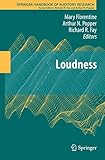Loudness / edited by Mary Florentine, Arthur N Popper, Richard R. Fay.
Tipo de material: TextoSeries Springer Handbook of Auditory Research ; 37Editor: New York, NY : Springer New York, 2011Descripción: xiv, 290 páginas recurso en líneaTipo de contenido:
TextoSeries Springer Handbook of Auditory Research ; 37Editor: New York, NY : Springer New York, 2011Descripción: xiv, 290 páginas recurso en líneaTipo de contenido: - texto
- computadora
- recurso en línea
- 9781441967121
- QP351-495
Springer eBooks
Overview: Definitions and Meaning of Loudness -- Measurement of Loudness, Part I: Methods, Problems, and Pitfalls -- Measurement of Loudness, Part II: Context Effects -- Correlates of Loudness -- Loudness in the Laboratory, Part I: Steady State Sounds -- Loudness in the Laboratory, Part II: Time-varying Sounds -- Binaural Loudness -- Loudness in the Real World -- Models of Loudness.
The topic of loudness is of considerable concern both in and outside of research laboratories. Most people have developed an opinion about some aspect of loudness, and many complain about the loudness of background sounds in their daily environments and their impacts on quality of life. Moreover, such sounds interfere with the ability to hear useful sounds, and such masking can be especially problematic for people with hearing losses, children, older adults, and non-native speakers of a language. At the same time, not all loud sounds are undesirable. Some loud sounds are important for human well-being, such as warning signals, whereas other loud sounds, such as music, can be pleasurable. In fact, loudness is essential for enjoying the dynamics of music. Thus, loudness is a pervasive and complex issue, and one that needs to be examined from a wide range of perspectives, and that is the purpose of this volume. Research in loudness has been performed in many countries, and this volume is an international endeavor with authors from Europe, Japan, and the United States, making the volume an attempt to provide a global network of information about loudness. The editors are very pleased to be able to bring together information on many aspects of loudness in this one volume, as well as to highlight approaches from many different perspectives.
Para consulta fuera de la UANL se requiere clave de acceso remoto.


